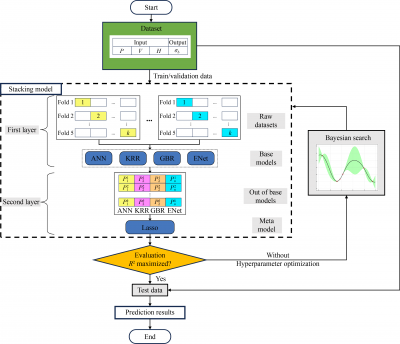A study led by researchers from South China University of Technology published a research paper in Frontiers of Mechanical Engineering, 2024, Volume 19, Issue 4. This study proposes a data-driven approach based on stacking ensemble learning to predict the mechanical properties of Ti6Al4V alloy formed by large-scale laser powder bed fusion (LPBF) for the first time.
When manufacturing Ti6Al4V parts via LPBF, the process involves numerous interacting parameters, making it challenging to determine appropriate parameters. Machine learning techniques can address this issue, but single models struggle to capture complex relationships. Stacking models, which combine the advantages of multiple models to enhance performance, are applied in this study to predict the mechanical properties of Ti6Al4V alloy in the field of additive manufacturing.
Spherical Ti6Al4V powder was used to prepare tensile specimens on specific LPBF equipment. The parameter ranges for laser power, scanning speed, and hatch spacing were set, and 64 parameter combinations were obtained through orthogonal array experiments. Algorithms such as ANN, ENet, KRR, GBR, and Lasso were employed to construct a stacking model for predicting tensile strength. Bayesian optimization and cross-validation were used to optimize the model, and multiple metrics were applied to evaluate its performance.
Pearson correlation coefficient analysis revealed that scanning speed has the greatest impact on tensile strength, followed by laser power, with hatch spacing having the smallest effect. After optimization, the optimal combination of base models for the stacking model was determined. Training and testing results show that the stacking model exhibits higher prediction accuracy and stronger stability than the ANN model, better capturing the complex relationships between process parameters and tensile strength.
The proposed stacking ensemble learning model provides an effective framework for predicting the tensile strength of Ti6Al4V alloy manufactured by large-scale LPBF. This study determines the influence degree of key parameters, validates the advantages of the stacking model in multiple aspects, and offers a reliable method for predicting the mechanical properties of metal parts in the LPBF process.
The paper “Machine learning enabling prediction in mechanical performance of Ti6Al4V fabricated by large-scale laser powder bed fusion via a stacking model” authored by Changjun HAN, Fubao YAN, Daolin YUAN, Kai LI, Yongqiang YANG, Jiong ZHANG and Di WANG. Full text of the open access paper: https://doi.org/10.1007/s11465-024-0796-0.
